
INTRODUCING LUMI
Anyone who works or lives with a child knows all too well just how demanding it can be to help them grow up! Accompanying them through their evolutionary challenges means finding out just whose hand we are holding every day. It is a stilted path: each step forward followed by another step back. We have to follow our hearts and our instincts, and trust our own common sense if we want to understand how to act and what to do. Thanks to studies in neuroscience, today we have a much greater understanding of how a child’s brain works and how the human mind develops, and this information is of invaluable importance in the world of education and pedagogy.
LUMI is the fruitful combination of neuroscience, pedagogy, and evolutionary psychology. This young and innovative publishing range focuses on the needs of families today, sensitively and competently creating products designed to promote children’s well-being in a global, efficient, and scientific way.
LUMI products are based on studies by various authors and researchers, and give parents and teachers easy-to-use, enjoyable, and scientifically based tools to help them guide children along their evolutionary journey in this digital, interconnected, and intercultural world in which we live.
Through enjoyable activities and games, our little explorers can fully express their potential in cognitive, emotional, and social development, accompanied by knowledgeable and encouraging educational guides. The key words are curiosity, reflection, emotion, and autonomy
Educating
the mind without educating the heart is no education at all. (Aristotle)
LUMI
LUMI is a small archipelago of islands, named after the old red-andwhite-striped lighthouse that served to light the way for all seafaring adventurers and guide them to the islands, where they could acquire a wealth of new knowledge, experiences, and skills.
LUMI CHARACTERISTICS
LUMI materials are mainly aimed at children but do contain a part for parents or teachers. In this way, the books or games can become an opportunity for adults to acquire new information on children’s development and how to fulfill their needs and respond to their behavior. Our products are designed for children who are independent, curious, contemplative, and creative; they are not passive learners but choose to be the protagonists of their own learning. Third-millennium children are the so-called “digital generation”: constantly connected to electronic devices and technology, they think and learn in environments that are fast, multimodal, and interactive.
With all this in mind, the traditional divides between the various fields of knowledge and disciplines are starting to crumble in favor of more project- and module-based teaching, in which the various disciplines integrate and intersect, creating a kind of conceptual map to explain a certain subject.
THE ARCHIPELAGO AND . . .
These are the foundations of the conceptual structure of LUMI. Graphically portrayed by a small archipelago of seven islands, each representing a different area of development, the islands are all connected to each other, as growth is a global process involving various cognitive, emotional, and social dominions, all of which are interconnected.
The products in the LUMI range belong to seven distinct—but interconnected—areas to stimulate integrated and global learning. The contents of the activity books and games have been created based on the specific goals indicated, and they can be summarized in seven large categories that are transversal to the age range and represented graphically by the seven islands of the archipelago:
FEELING


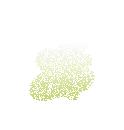








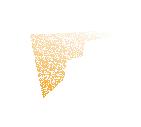









REASONING




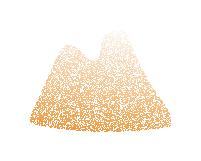


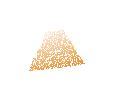
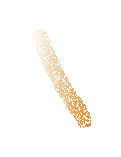

THINKING













COMMUNICATING
COOPERATING
CREATING EXPLORING
. . . ITS INHABITANTS
You will also find some friendly companions among the animals living on the island, who have taken on the role of accompanying our explorers, based on their age group.
0–3 years 3–5 years
Logi Uniq
This hermit crab is a sweet little animal. His strong shell means he can hide away whenever there’s a predator about. Logi is the perfect companion for our youngest adventurers, protecting them as they gradually explore the world around them until they can eventually shake off their shells and wander off to new horizons, confident in their newfound skills.
Another resident of the LUMI archipelago is the sea turtle. As soon as they can move, these brave creatures head for the sea, never looking back. Uniq is the perfect companion for our young but intrepid explorers as they enthusiastically head off on a voyage of discovery of basic skills, encouraged by their conquests in physical, linguistic, and social skills.
5–7 years 7–9 years
Mega Ido
Our third friendly animal guide is the whale. Since the beginning of time, whales have always fascinated humankind, representing a symbol of humanity itself and of a search for knowledge. Mega’s fellow adventurers are strong and determined, ready to leave dry land behind and sail the seas to the very abysses of knowledge, on a discovery of their own individuality.
And finally, everyone in the LUMI archipelago has an invaluable friend in the seagull. Free, independent, determined, curious, and loyal to the group, Ido the seagull accompanies our more mature adventurers as they leave the safety of the shore to explore the more complex areas of the world of knowledge, transforming themselves into young but skilled leaders.
A FEW TIPS FOR PARENTS
Self-esteem is the story we tell about ourselves.
If I asked you to tell me the characteristics you hope your son or daughter will possess as an adult, you would certainly write a long list of virtues, and it’s likely that good self-esteem would be one of them. Indeed, it’s indispensable while growing up: the concept of self influences the way we relate to others, move in the world, explore with greater or less confidence, seek security, and learn to protect ourselves when we are in difficulty.
Self-esteem shouldn’t be confused with just having a positive image or positive feelings about oneself; it’s more to do with awareness of oneself and of others. It’s built through the things we learn about ourselves during our experiences and through the role models in our lives as we are growing up. A child builds their image of themself from the image they see reflected in the eyes of the significant figures in their life, which include parents, family members, teachers, and also friends.
Books on the subject say that a child is more likely to feel valued if they have parental affection, well-defined boundaries, and a respectful educational approach. Children develop better self-esteem when their role models are loving and non-judgmental, and when there is clear and
unambiguous communication, in which their ideas, thoughts, and emotions are listened to, making them feel respected as unique people, being valued for who they are, and not on their performance or in comparison to others. This doesn’t mean letting them do or say anything they want without any boundaries. It’s about seeing and embracing their desire, recognizing their need to be curious and for self-affirmation, not suppressing it by mortifying or humiliating them, but rather giving them clear and coherent boundaries that are then perceived as supportive and not as inhibiting or nullifying the self.
It’s important to remember that we build our child’s internal narrative with the way we relate to them, and the story that they create about themself repeats itself every time they interact with others and the outside world. That look of trust, or those words of disappointment, will become part of their internal dialogue in their everyday life, accompanying them throughout their stages of development. So, it won’t be our active gestures of protection that build their image of being safe or capable, but the meanings that our actions convey: I’ll do it for you because you’re not capable; I’ll correct your mistake because I’m ashamed of you; I’ll protect you from everything because the world is a dangerous place, and you can’t do it on your own. Or, I watch you try and try again because I trust in your abilities; I know you can do it; I’m confident you’re going to make progress; I believe every mistake is useful; and so on.
FOR CHILDREN OF YEARS
5-7
CHAPTER 1

Who Am I? Knowing Myself, Accepting Myself, Expressing Myself
WHO AM I? KNOWING MYSELF, ACCEPTING MYSELF, EXPRESSING MYSELF

Everyone’s Different and Unique

Have you ever thought that all the living things in the world are UNIQUE ? You won’t find two identical lions, or two giraffes that are exactly the same, or two trees with the same leafy branches, or even two flowers with exactly the same characteristics. All of them will ALWAYS have a DISTINCTIVE feature. And the same goes for people: each of us is UNIQUE , and that’s why everyone is special!
FIND the pairs and CIRCLE the differences you FIND with a pencil!
12
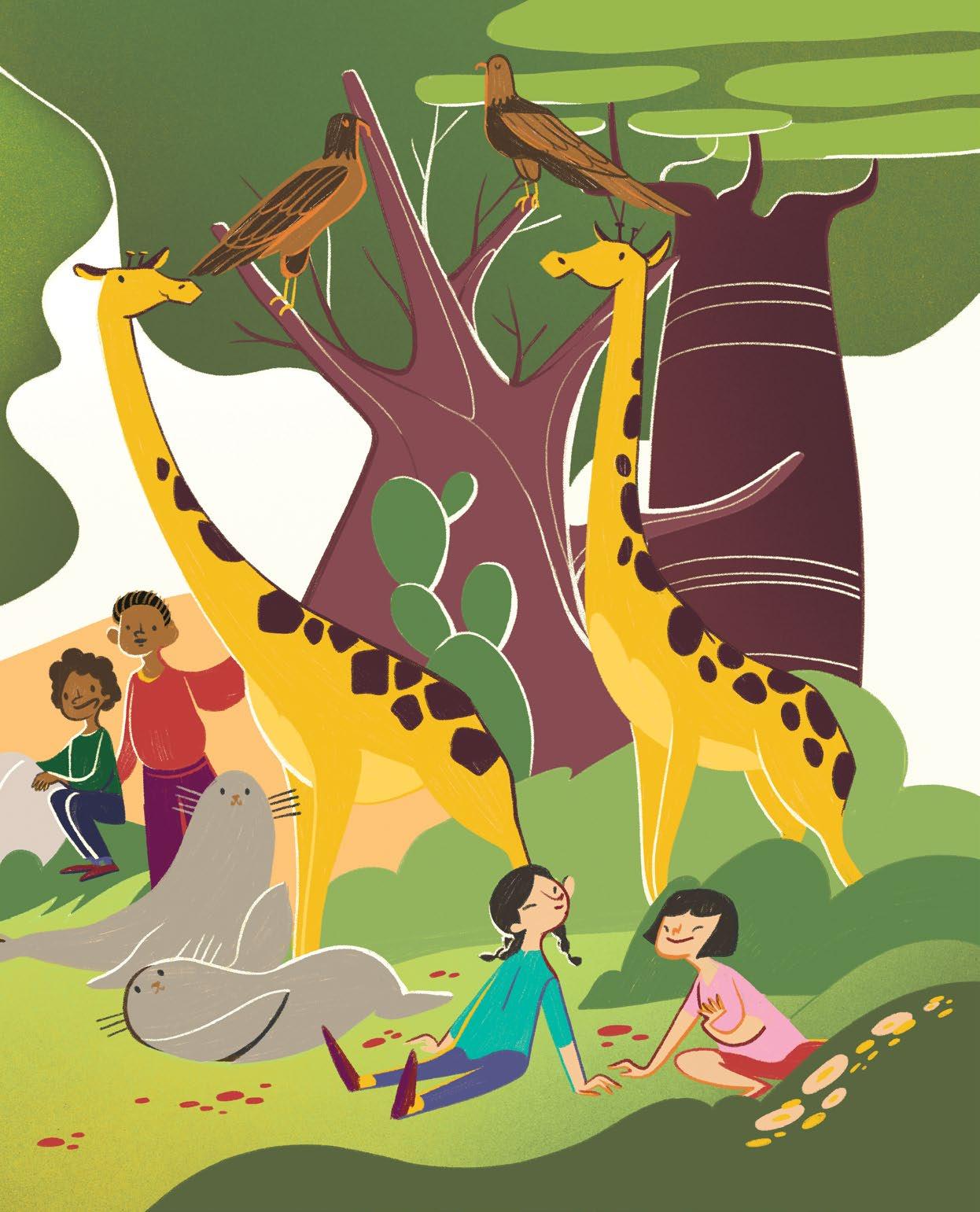
13
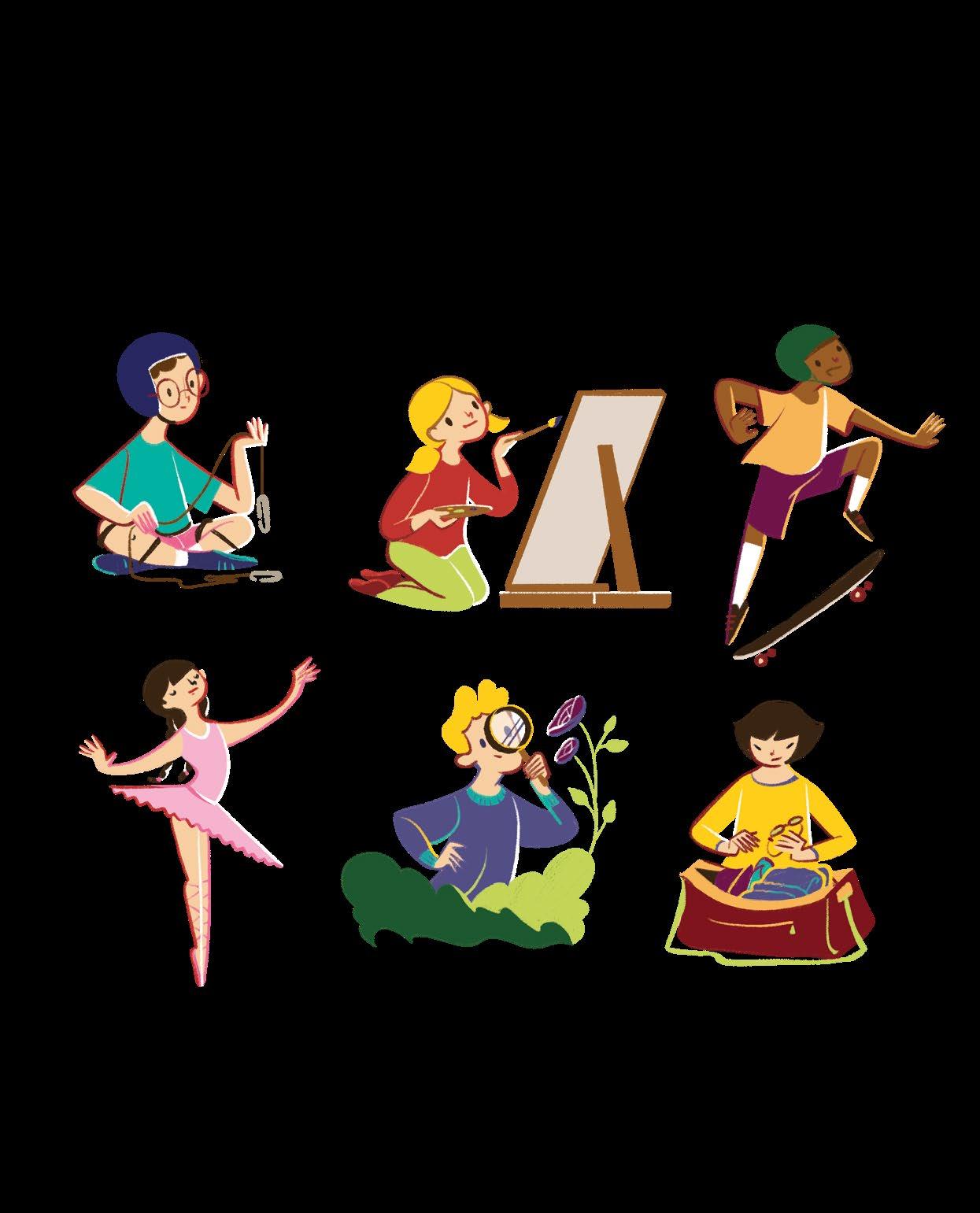

Each to Their Own Interests
We are also all different because we like different things! I love cooking, Ben loves music, and our friends all have different interests too. LOOK AT THEM and find out what they are passionate about, then CONNECT the drawing to the corresponding word.
BALLET SKATEBOARDING
ROCK CLIMBING EXPLORING
PAINTING SWIMMING
14
WHO AM I? KNOWING MYSELF, ACCEPTING MYSELF, EXPRESSING MYSELF
My Passions
What are your passions?
COLOR in all the drawings of the activities you like doing.
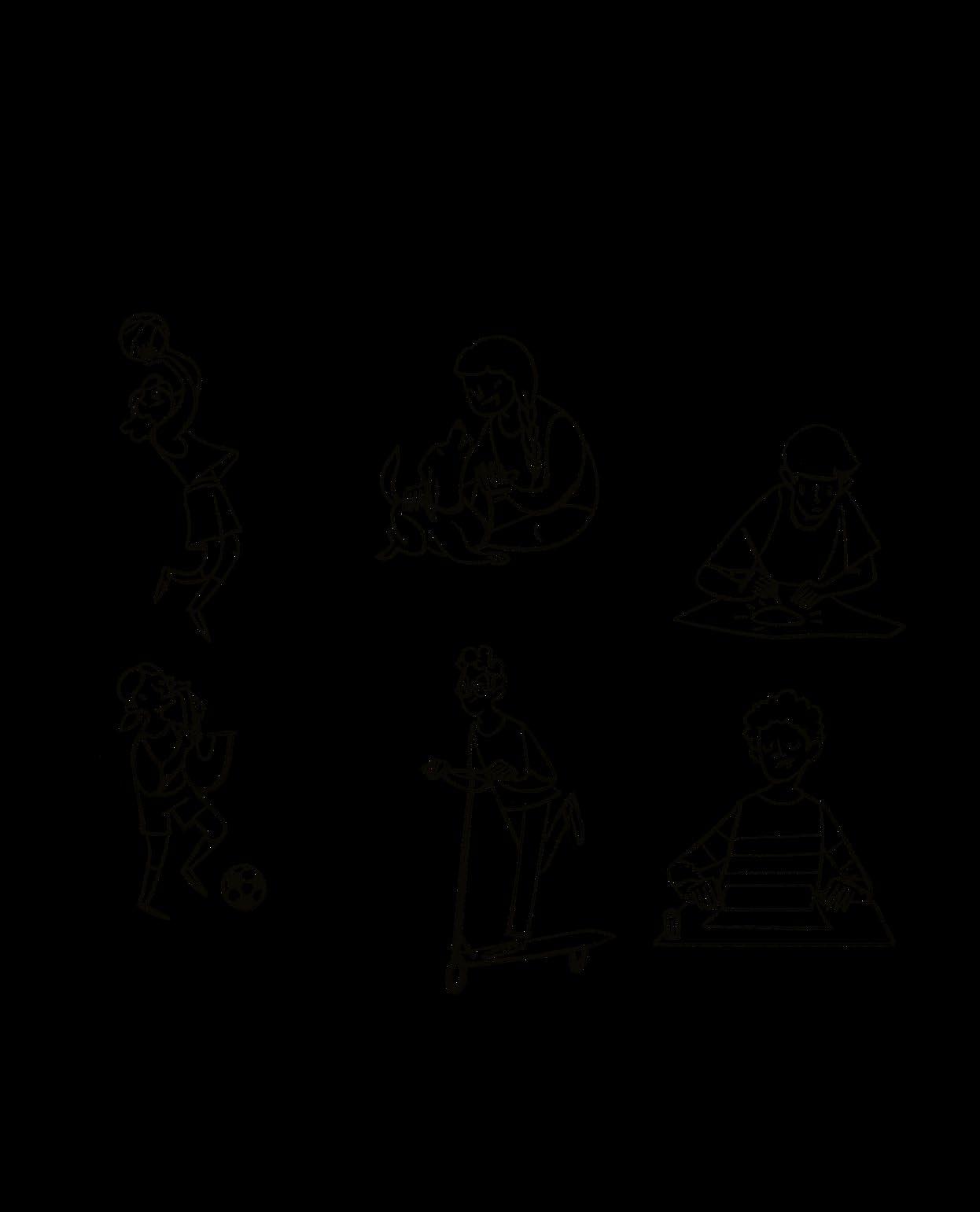

TELL ME: When did this passion of yours start?
Do you remember a time you did something exciting?
........ 15
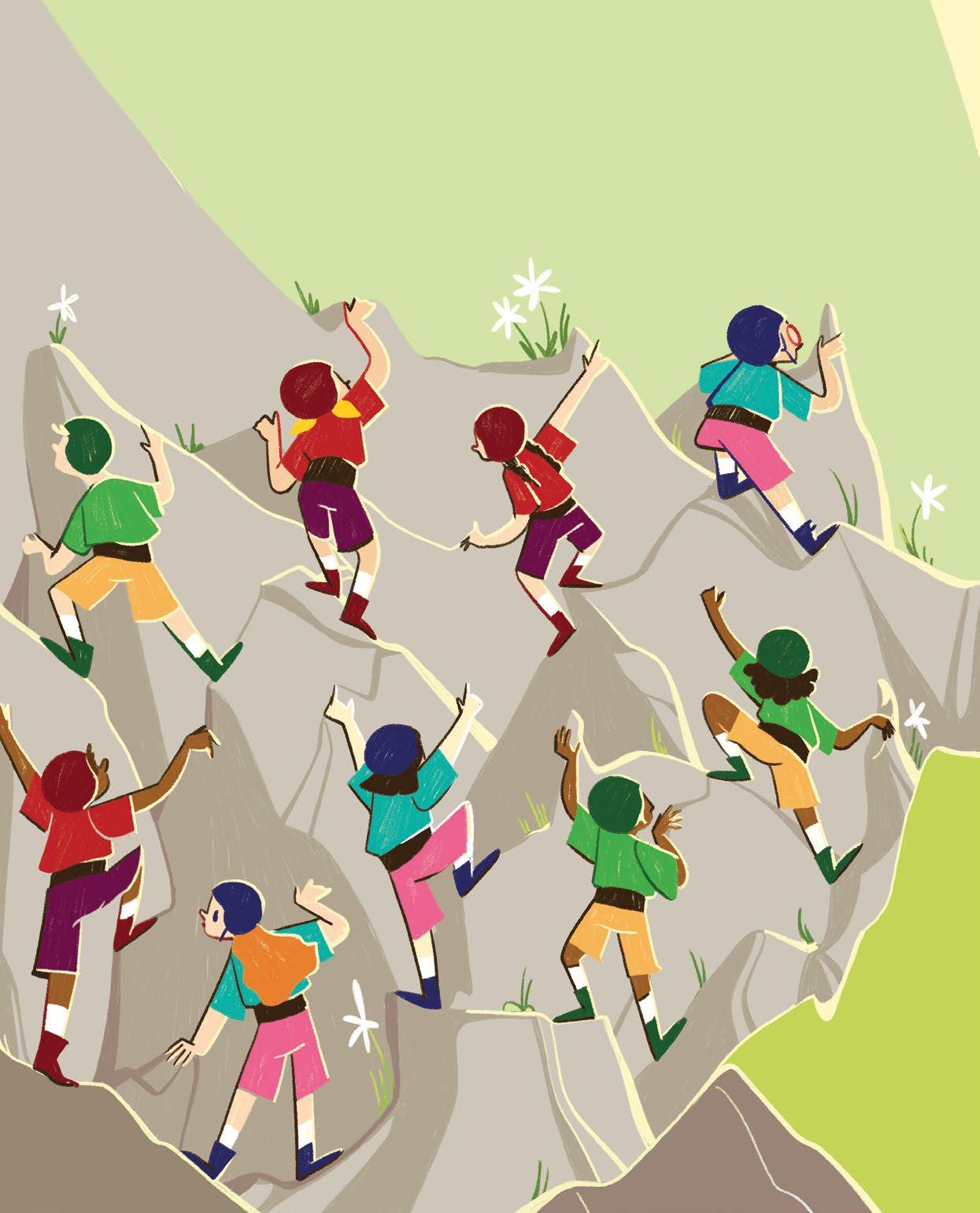
Friendship
In life, it’s important to have friends to experience both difficult and beautiful moments with. These three groups of kids are climbing a rock face. CONNECT all the kids in the same group with the rope, starting from the top.
LIS __
__ ST ___
___ TEN ___ SPE U __ ING __
TR
CT
RE
24
SELF AND OTHERS, EMPATHY AND ASSERTIVENESS
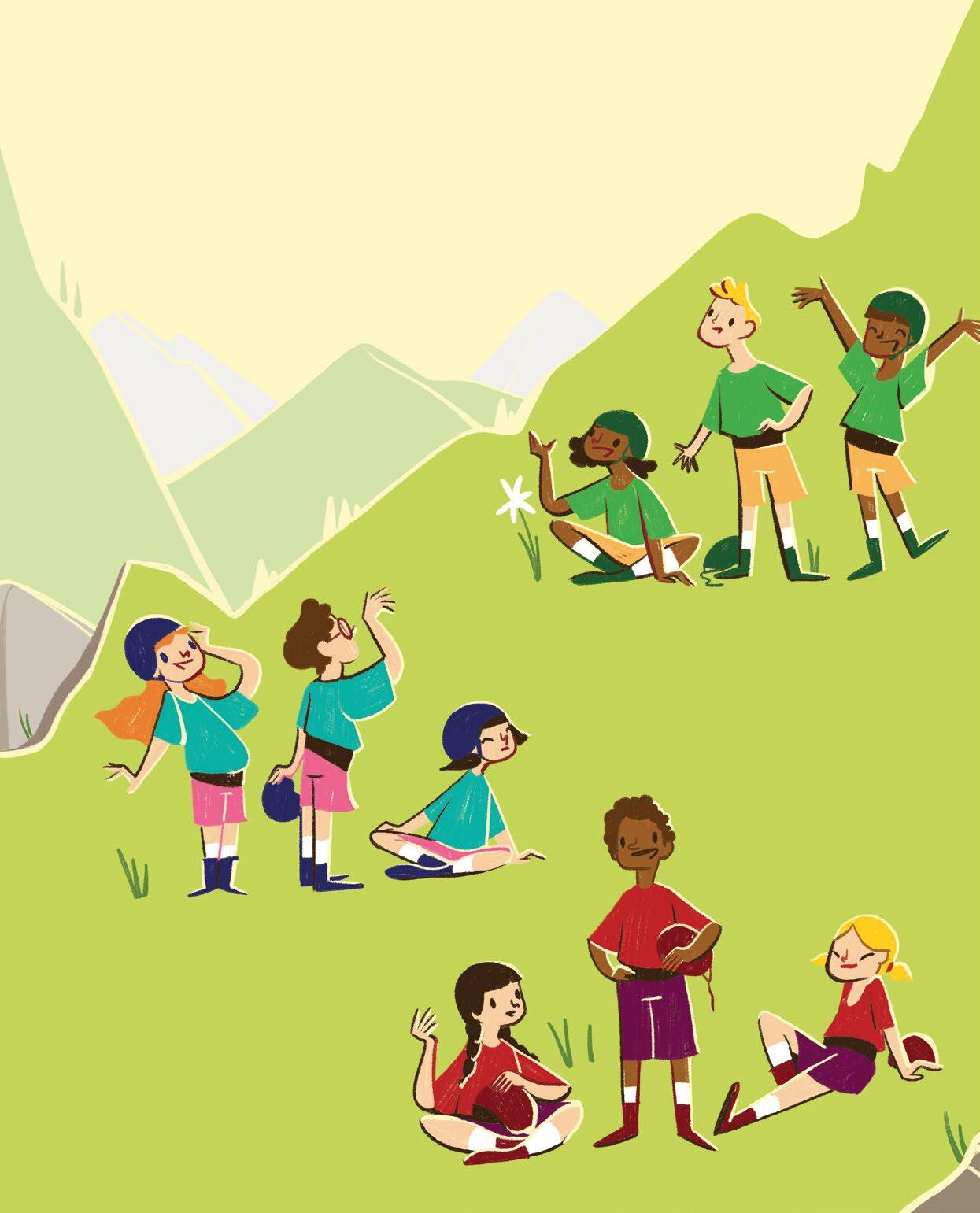
Now, CONNECT the pieces of the words, and rewrite them on the dotted lines below each group, thereby forming the words that describe the most important quality in their friendship.
_______ ________ _______
25
SELF AND OTHERS, EMPATHY AND ASSERTIVENESS
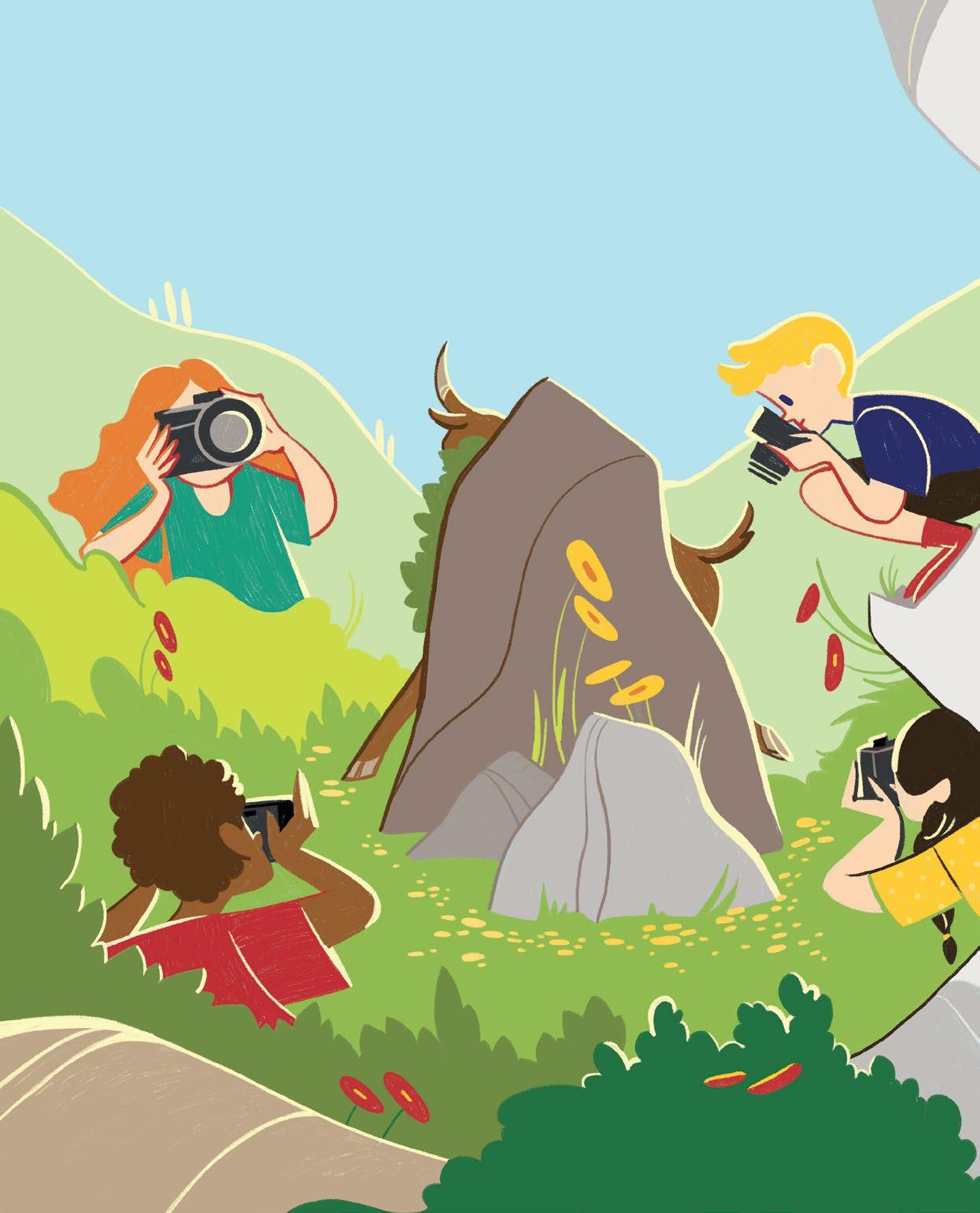
Points of View
Seeing things from different points of view can be a resource! It allows you to see things you wouldn’t see on your own! LOOK at these four kids on a day trip in the woods: they’ve found an animal, and each of them is taking a photo of one part of its body.
26
What kind of animal do you think it is? Let’s FIND OUT ! COLOR the frame of each photo with the color of the shirt worn by the kid you think took the photo: that’s their point of view. Then WRITE the number of the corresponding photo on the drawing. Finally, COLOR the drawing and find out which animal is behind the boulder!
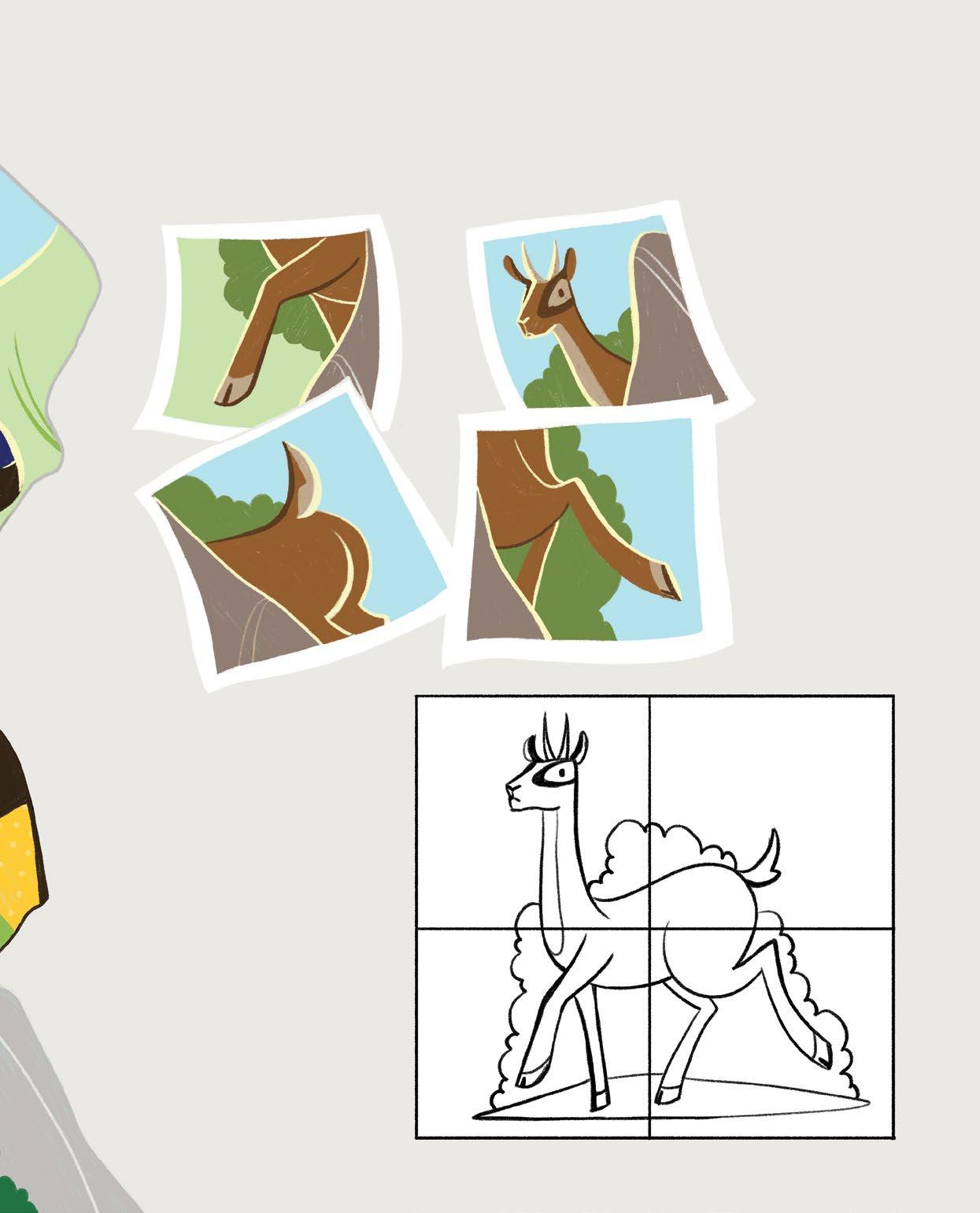
You can only see the whole animal thanks to all of the kids’ points of view!
27
1 2 3 4
SELF AND OTHERS, EMPATHY AND ASSERTIVENESS

Understanding Emotions
When we’re with other people, it’s important to recognize the emotions that we and others are experiencing. How much of an expert in emotions are you? Rearrange the jumbled letters under each face, and WRITE the name of the emotion they are expressing underneath.



- -- - - - - - - - - - -- - - - - - - - - - - - - - - - - - - - - - - - - - - -- - - -- - - - -- - - - - - -- - - -
OJY GERNA DESANSS
ONNATISIGER AREF STISDUG
URPSSIRE DROBEMO
28
BARREMMASSNET
An Emotional Week
Try to recognize your emotions for a whole week! In the row for each day, indicate the main emotion you felt throughout the day with an X . At the end of the week, you’ll see which emotion you felt the most often.
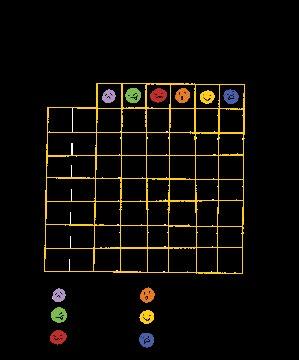
MONDAY TUESDAY WEDNESDAY THURSDAY FRIDAY SATURDAY SUNDAY SURPRISE ANGER
JOY FEAR 29
SADNESS DISGUST

Resilience
BEN is very sad because he can’t shoot a basketball.
ENTER the labyrinth in his brain, and find the path that forms the secret phrase to help him stop being sad. Every time you FIND a letter, WRITE IT on the dashed line below.
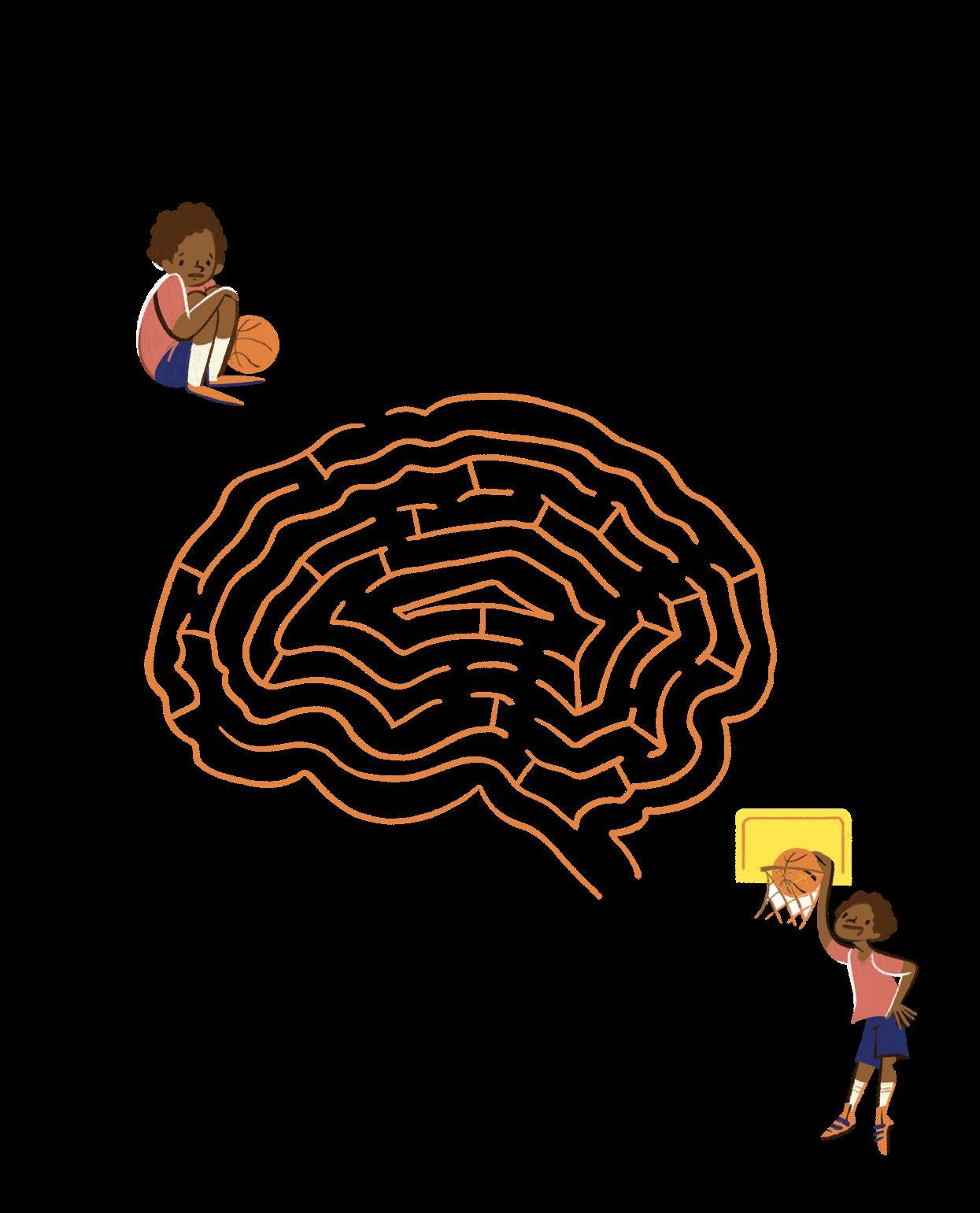
If at first you don’t succeed, try, and try again, and you will reach the finish line!
MY RESOURCES- --- -
I A N D C O I T
44
What’s the phrase?
Strength
How will Ben feel when he shoots a basketball after trying so hard?
CONNECT the dots to FIND OUT.
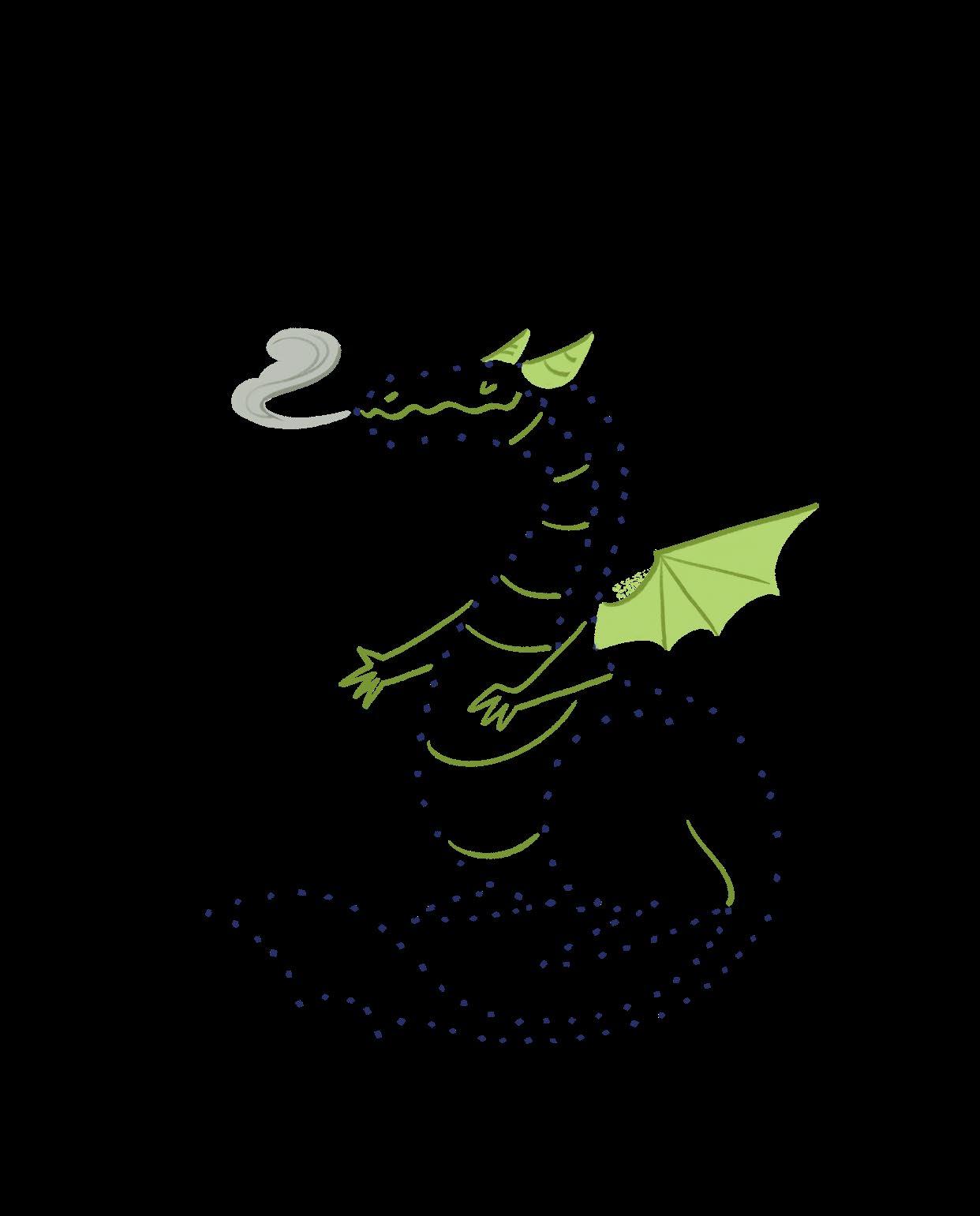

Remember, you’ll feel really strong after putting in the effort!
45


































































